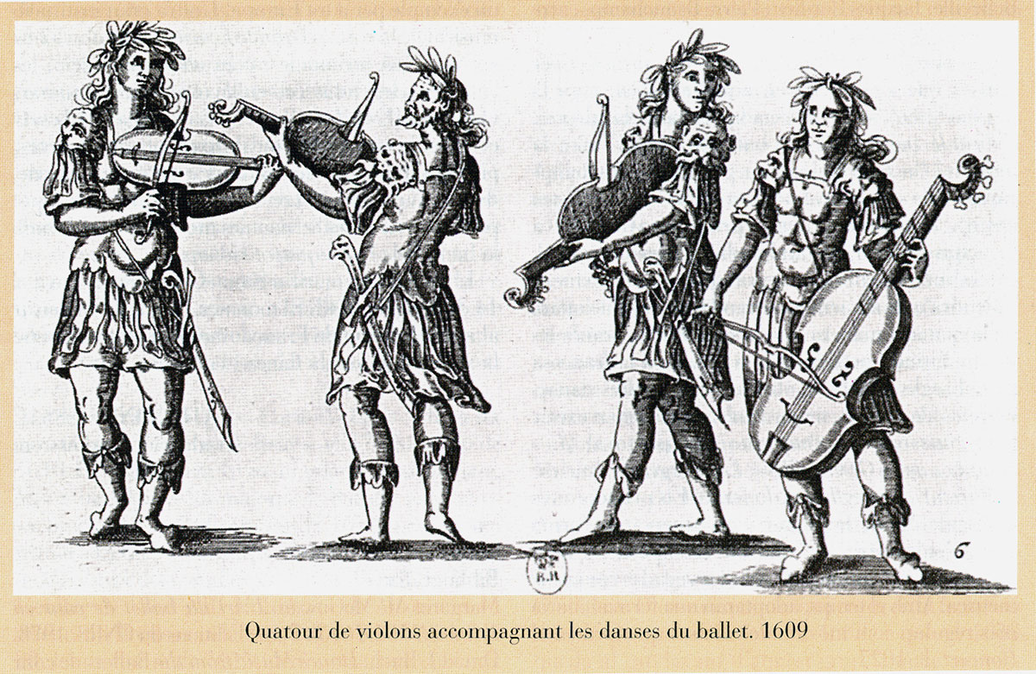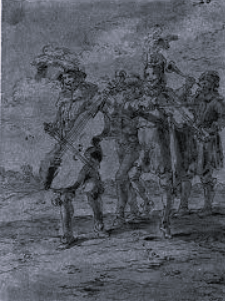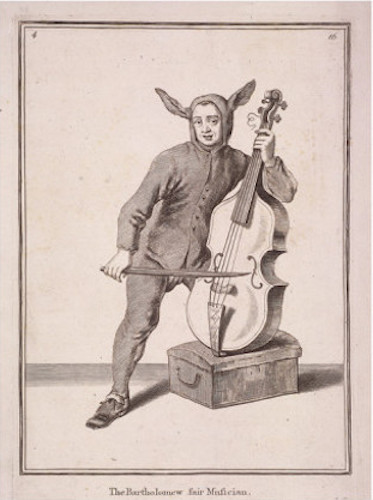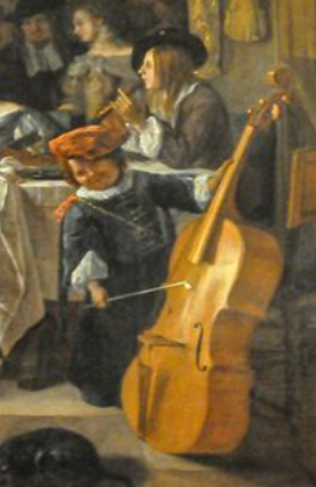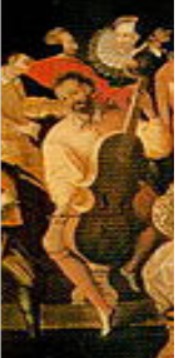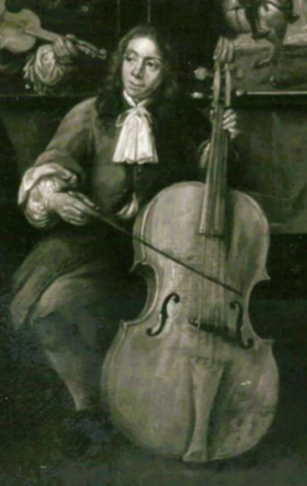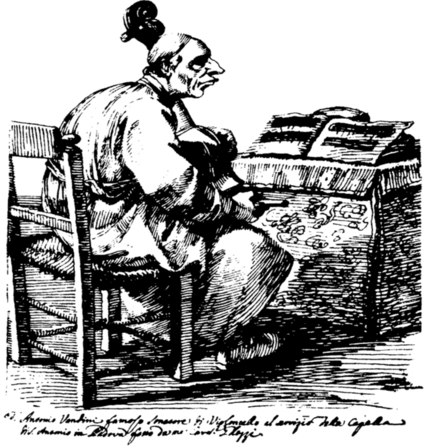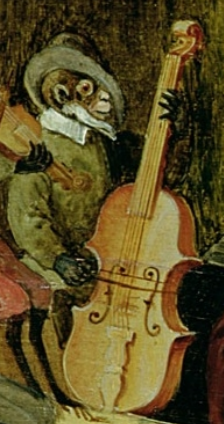Technical aspects
Bow hold
Throughout history there has been more than one way to hold the bass violin bow. It can be seen in the depictions of the time that players of early bass string instruments used both underhand and overhand bow holds. The underhand grip, still commonly used by viol players, consists of placing the palm of the right hand at the frog and the thumb over the stick to create a counterweight between the bow and the strings. The rest of the fingers take various positions. There are numerous paintings in which the middle and ring fingers are placed on the hair of the bow and in other paintings just the middle finger. Of course, depending on the school there were and still are other variations of holding the bow. Due to the lack of screws on the bows that would permit the player to adjust the tension of the hair, the main purpose of these fingers on the hair was to enable the player to articulate, by pushing the hair against the string. In Mark Smith´s article The cello bow held the viol way; once common, but now almost forgotten, he suggests that holding the bow in this way might have been due to the fashion of the time, in which the players wore long heavy sleeves that hindered the movement of the right hand.1
There exists the possibility that the musicians who played the basse de violon also played the viol, for this reason one might assume that they would have played initially with an underhand bow grip, as it was the technique that they were used to. This underhand grip, however, does not seem to be the one used by all the basses de violons players in France. Even though the depictions of the time show street musicians, clowns or actors in France holding the bow underhand,2 Georg Muffat described in his Florilegium Secundum of 1698, that the violins in Lully´s orchestra played also if needed both middle and lower voice (hence not a viol player).3 In contrast with what I previously said, that may suggest that the basses de violons players of the Vingt-quatre violons du Roi were more familiar with the technique of the violins than with the one of the gamba, and consequently, the overhand grip.
Each part, and thus the middle and lower parts as well, should be played not just by bad or weak violinists, but also by some good ones, who should not be insulted to be assigned to these parts which are as worthy as the others.4
Georg Muffat also recounted in his Florilegium Secundum of 1698, that in Lully´s orchestra the bow-hold of the violinists and the basses were were mostly the same:
Most Germans agree with the Lullists on the holding of the bow for the violins and violas; that is, pressing the thumb against the hair and laying the other fingers on the back of the bow. It is also generally held in this way for the bass (what I believe to be a basse de violon) by the Lullyists; they differ from the Italian practice, which concerns the small violins, in which the hair is untouched, and from that of the bass gambists and others, in which the fingers lie between the wood and the hair.5
This could explain why in the depictions of the Vingt-quatre violons du Roi the basse de violon players use the overhand bow hold. The fame and importance of this orchestra and its musicians during its lifetime might have been the reason why this overhand grip became the most common bow hold internationally until today.
Regardless of the Lullyists, we still find references in different treatises at the end of the eighteenth century that indicate the use of underhand bow technique. In Charles Burney´s book The Present State of Music in France and Italy,6 there is a description of how the famous player Antonio Vandini used the underhand bow grip in Italy in 1773:
It is remarkable that Antonio, and all the other violoncello players here, hold the bow in the old fashioned way, with the hand under it.7
By using the words 'the old fashion way' Burney implies that the underhand grip could have been the most common way of holding the bow, not the overhand grip.
Some years later, in an article published in Leipzig (1799)8 describing the underhand technique of the renowned cellist Johann George Christoph Schetky, we can find a perfect description of one way to hold the bow:
It will be difficult for me to make others understand this method of holding the bow. Usually, the bow is held with the thumb under, and with the four fingers directed over the stick, as with the violin, only that with the violoncello the arm hangs downwards, and the bow-strokes are directed downwards, whereas, with the violin, the arm is bent, the hand is raised, and the bow must be directed upwards. With Schetky it was otherwise. The thumb lay on the frog of the bow, the index finger was alone on the stick, and the three other fingers were down on the hairs. Through the pressure of the lower fingers, especially the little finger, he conspicuously increased or decreased the pressure of the bow, and brought forth by this means the greatest power of the depths of the sweetest oboe-tone in the upper regions. This method is right from mechanical and physical grounds. By this means the player has the action of the bow rather more under his control, because [when] playing with the bow directed downwards, anyway, the strength is taken away from the hand because of the lowered arm, whereas [the strength] is released by the bent arm turned upwards. In the first case, the blood flows more in the part of the arm directed downwards and interrupts the strength of the muscles because of the swelling up of the arm. With the violin, it works the other way. The blood flows back because the arm is raised and therefore lets the muscles have their freedom. However, much practice is needed for this bow-hold, which I would recommend nevertheless to beginners on the violoncello, for the reasons presented above.9
Although we have such material as this explanatory article about Schetky in Germany, there remains a shortage of written information within the treatises about the underhand bow technique on the bass of the violin family in France. Therefore, it is difficult to formulate a definite conclusion as to which of the techniques of bowing was most commonly used and favored by instrumentalists.
As previously suggested, a performer’s choice of one or other bow hold might be one of convenience based on whether the performer approached the bass instrument as a viol player or as a violin player. Perhaps a versatile musician was able to play with both an underhand and an overhand bow grip.
Posture
The way of holding the basse de violon was never standardized. In the depictions we find musicians sitting down holding the instrument between their legs, others put the instrument on the floor, and some players are standing with the cello on a stool. There are even some standing up with the cello held by some kind of strap around the body of the player. The reasons for these different postures are diverse. The main two reasons are: first, the considerable size and weight of the instrument that didn´t permit the instrumentalist to move freely, and second, to allow the player to move about or sit down, depending on the occasion.
To understand better why a player must have chosen one or other playing position I selected various depictions of musicians from this time, and I played the basse de violon imitating them. Using the videos of my different experimentations with the instrument I will now explain the reasoning behind the postures.
Experiment 2:
The instrument, leaning to the left of the musician´s body, stays between his knees as in the previous depiction, but this time the instrument sits on the floor. Due to the large dimensions of the basse de violon, it was probably heavy and thus uncomfortable to hold in the legs for a long period. The bowing angle of this musician is diagonal. This way of bowing is a result of the way this musician is holding the instrument.
I discovered this for myself while imitating the musician in the painting, it was hard to bow without hitting the instrument or my body. Years later Michel Corrette advises against supporting the instrument in this way:
[…] and observe that the Instrument does not touch the ground, since it makes it unable to sound.10
In my experiment, the thing that I found most difficult was maintaining the position of the instrument without it slipping away from me. To overcome that obstacle I put a little plastic mat under the instrument to stop it from moving. The sound that I was able to make was coarse, but it was easy to accentuate notes. I believe that this posture limited the musicians to playing only basic bass lines.
Experiment 4:
There are several depictions of musicians resting the instrument on a box, a book, a cushion, their left foot or another object This was done for different reasons. It created a support that raised the height of the instrument. In this depiction, the musician is standing up. The need for the support might have been based on the size of the instrument relative to the size of the instrumentalist, it could enabled the player who would otherwise have felt uncomfortable with the instrument at floor level. In other depictions, musicians are sitting down, but also putting their instruments on a support object. One could imagine this to be a solution for the instruments that didn´t have an endpin.
In this experiment I decided to grip the bow imitating the posture of the player in the engraving. It made the instrument speak faster because I had contact with the hair of the bow and the strings aren´t easy to bow while you have your knees folded. I believe that this posture would have allowed the player to perform well in every situation.
Experiment 5:
Both knees on the floor, or seated with one knee on the floor. Again I had to use rug because the instrument kept slipping away. I found the underhand bow hold more comfortable for this posture, it helped in holding onto the instrument better. I don´t believe one can play virtuoso passages in this position, and I think it confined the instrumentalist to really basic bass lines.
Experiment 1:
This playing position is similar to the one used by viol players. In this depiction the instrument is placed between the knees and does not touch the floor. In Jambe de Fer´s Epitome, the author explains how the instrumentalists would position it:
Some performers place the instrument ―right on the knees [in the Italian manner…] the French, [however,] make very little use of this method.11
Not everyone was fond of this playing position, in the same book we find an acid comment by Silvestro Ganassi (1542) expressing his disapproval, calling the posture 'Moorish'. The stool that the musician is using looks small in comparison with the size of the player. Years later Corrette advised cellists who used this placement of the instrument between the legs and raised off the floor of the importance of the size of the chair when one wants to make a nice sound:
In order to play the cello well, it is necessary to sit on a chair or stool of a size proportional as much as possible to one's height so as not to be seated too close to the edge.12
For me, this placement of the instrument was the one which felt most natural because the posture is similar to the one that I use to play my cello. Holding it between my knees and not having it standing on the floor gave me a comfortable steadiness that I didn´t find in experiment two, with the instrument on the floor.
Experiment 3:
This way of holding the instrument was really common. The instrumentalist would fasten the instrument to his body with a strap. As Ludovico Zacconi explains in his Prattica di Musica, this posture permitted the musician to play in different places and for different events, such as weddings and marches. It gave him the facility to move around as he wished.13 In my video, I wasn´t able to hold the instrument like that. This position would require making an incision in the back of the instrument to attach a hook for holding different kinds of straps, scarves or strings.
In 1556 Jambe de Fer explains how to do it:
[The instruments] are held upon the arms, some with a scarf, cord, or something else. The bass, because of its heaviness, is very troublesome to carry; hence it is supported with a little hook in an iron ring, or something else, which is attached to the back of the said instrument quite suitably, […so] that it does not hamper him who plays upon on it.14
Because of the weight of the instrument itself, the backs of several instruments in which the mechanism had been installed needed several repairs to repair the damage to the body of the instrument. In my experiment I had to focus on three main issues. First, the instrument wasn’t really stable as it moved along with the motions of my body. Second, I had to use a different left hand grip, placing my fingers obliquely on the strings as violinists do. Third, after several unsuccessful attempts to bow smoothly, I used the underhand bow grip which felt more natural and seemed easier.
In summary, sixteenth and seventeenth century bass violins were held in different ways. This variety allowed the musician more freedom when playing. However, after completing these experiments, I believe that few of these playing positions could be used in playing more virtuosic music other than the most basic bass lines.
Figure 20 Author unknown: Queen Elizabeth dancing the volta with Robert Dudley, Earl of Leicester (c. 1600). Detail.
